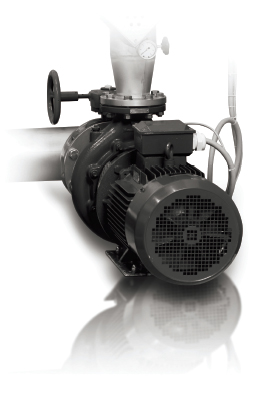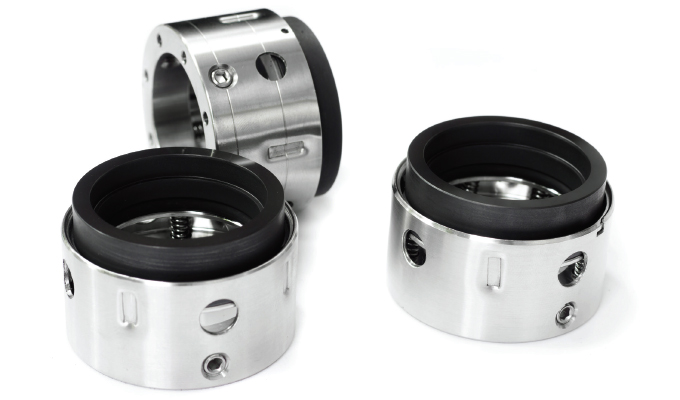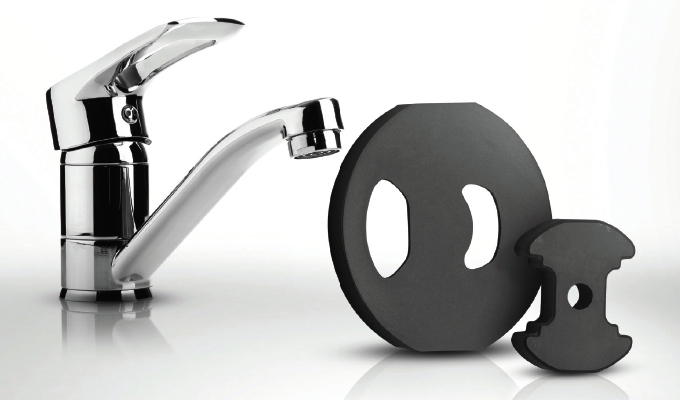Components used in water, lubricated, or submersed environments, face considerable tribological challenges that can ultimately affect performance and reduce the life of the larger system—particularly those that come in contact or slide against other parts. This process includes pump parts, mechanical seals, and high-pressure valves manufactured often using ceramic substrates designed to survive wet, corrosive environments. Unfortunately, these substrates are also easily damaged due to high friction of sliding/mated parts due to a consistently high coefficient of friction (COF) when uncoated.
With that in mind, the goal is to keep the COF of sliding parts as close to zero as possible. The COF is the measure of the amount of friction existing between two surfaces. A low value of COF indicates that the force required for sliding to occur is less than the force required when the COF is high. Typical values for the COF when sliding is occurring between polished oiled metal surfaces, for example, is 0.1.
Fortunately, there are industrial thin film coatings available that can reduce friction to dramatically improve the life and performance of critical components. Such coatings, so called diamond-like carbon (DLC) coatings, can increase the surface hardness of even hard, ceramic substrates while significantly decreasing their COF.
One coating in the DLC family, tetrahedral amorphous carbon (ta-C), has unique tribological properties for water environments that testing demonstrates can reduce the COF to levels that consistently approach 0.1 to 0.2, even in wet or dry running conditions. Best of all, the coating can be applied through experienced toll processors at a very low cost per part, increasing the performance and life of critical parts.

REDUCING FRICTION WITH SPECIALIZED COATINGS
Within the universe of wear resistant thin films, DLC coatings have emerged as the ideal solution for demanding physical applications where components are under high loads or subject to extreme friction, wear, and contact with other parts. In these types of environments, the high hardness of a DLC coating—along with a corresponding low COF—can prevent parts from pitting, galling, seizing, and ultimately failing in the field.
For many, DLC Coatings are hydrogenated amorphous carbon (a-C:H) coatings, but this is a misconception. Coatings within the DLC family can be highly engineered based on factors such as hydrogen content (hydrogenated or hydrogen-free), the selection of additional metallic and non-metallic doping elements, the presence of sub-layers, and the choice of deposition and bonding methods.
Together, these factors can be precisely controlled to create a broad range of thinly applied (typically 1 to 5 μm) DLC coatings with a hardness of 8 to 80 GPa.
Within the DLC coating category, the hydrogen-free formulations do not only provide very high hardness but also an extremely low COF in water environments. Reducing friction when components are sliding against each other is critical, particularly in boundary lubrication.
According to Dr. Oliver Jarry of Oerlikon Balzers, a company that produces specialized DLC coatings for components globally, the advanced ta-C coating Balinit Milubia has the best tribological properties for reducing COF in water environments.
With a typical hardness of 40 to 60 GPa, ta-C coatings are an excellent choice for components that are exposed to extreme operating forces over the long-term, such as shafts and seals, where friction can cause components to overheat or fail.
The ta-C coating is typically applied in a thickness of only 0.5 to 2μm using a method of physical vapor deposition (PVD) by arc evaporation. This produces ta-C, which has substantially higher abrasive wear resistance than a-C:H alternatives.
Because the coating can be applied at a temperature below 150 degrees Fahrenheit (65 degrees Celsius) unique even within the DLC family, it can be applied to thermally sensitive substrates such as polymers and elastomers that before now have been difficult to coat.
“Among all DLC coatings, Balinit Milubia provides the lowest friction coefficient possible compared to other materials and uncoated metals, ceramics, polymers, and elastomers in water environments. Even under dry running conditions, the ta-C coating can deliver a very low COF that approaches zero,” says Dr. Jarry.

RESOLVING COATING CHALLENGES
The unique properties of ta-C coatings allow manufacturers to resolve some of the challenging issues for components made of ceramics, polymers, and elastomers including hydraulic pump parts, mechanical seals, and high-pressure valve components.
Ceramic Components
Pump, valve, and faucet components are often made of ceramics such as alumina and silicon carbide due to relatively low cost and superior corrosion resistance over metals in wet environments.
Since ceramics are already very hard, wear is not typically a major concern. Although the ta-C coating can increase the hardness of an alumina component from 2,000 Vickers to approximately 4,000, that is not the primary objective. Ceramics can still be affected by high friction, however, which wears down parts quickly and can increase internal operating temperatures to levels that can damage nearby components. In these cases, a ta-C coating can dramatically reduce the COF and associated thermal rise.
The coating also out-performed typical PVD coatings such as chromium nitride—another option designed to create an extremely hard, corrosion resistant surface—which averaged between 0.5 and 0.7 COF in the SRV test when applied to alumina.
According to Dr. Jarry, one potential application is coating ceramic seal discs used in most faucets and shower heads. During installation, grease is applied to facilitate faucet activation. Over time, the grease can gradually wash away, increasing friction during faucet activation and affecting precise flow and temperature control. This can affect customer reviews, given that smooth control and operation is considered a sign of quality for high end faucets.
In addition, faucet activation forces remain low even if assembly grease is washed out. The coating reduces lime deposition as well, which exacerbates wear and friction and can shorten the life of the product.
Another potential application is ceramic pump shafts and bearings, which are expected to perform reliably over the long term in corrosive conditions. When coated with ta-C, these parts approach a COF of 0.1, compared to nearly 0.5 uncoated.
Perhaps even more importantly, the COF is nearly the same under dry running conditions. This protects pump components like ceramic seals or O-rings from friction, thermal rise, and damage if an operator runs the equipment “dry.”
Mechanical seals for centrifugal water pumps, for example, are often made of SiC. Typically, dry running mechanical seals or O-rings can “burn” them, causing failure and requiring premature replacement. Lowering the COF reduces the heat generation and allows longer dry running times without failures.
“In this type of situation, the coating essentially allows the pump to survive despite some misuse,” explains Dr. Jarry. Less friction lowers the energy consumption as well, he adds.
Polymer Components
Unlike ceramics, polymers are relatively soft and quickly wear or are damaged in high contact, high friction applications. When the ta-C DLC coating is applied over a polymer substrate, it can provide a coating hardness of up to 50 GPa to increase component durability and lifespan. However, polymers are traditionally difficult to coat with DLC coatings.
“Polymer substrates have low thermal stability so can melt or deform at the higher temperatures that most PVD coatings require,” says Dr. Jarry. “Fortunately, the ta-C coating can be applied at a temperature below 150 degrees Fahrenheit (65 degrees Celsius), which is low enough to avoid thermal deformation of most polymers.”
Traditional coatings are also difficult to apply over an insulating substrate. With excessive friction, polymers tend to accumulate an electrostatic load that could cause severe damage if not safely discharged. As a solution, the ta-C DLC coating can attenuate or evacuate electrostatic discharge (ESD) on polymer substrates and also modifying its surface energy. The same process can be used to increase or decrease the wettability of polymers as required.
Elastomer Components
Like polymers, elastomers are inexpensive substrates that are typically left uncoated because few technologies are suited for the task. Elastomer substrates generate high friction, which leads to energy and efficiency losses.
Tribology tests of an NBR elastomer coated with ta-C conducted by Oerlikon Balzers demonstrated that the COF remained near 0.1, despite altering the speed and load of the sliding/contacting parts. In contrast, the uncoated NBR exhibits COF values 10x higher, approaching 1.0.
One potential application is for sealing rings in motorbike fork tubes. Decreasing the COF can substantially reduce seal wear, while reducing stick/slip conditions. The result for the rider would be superior performance and a smoother, more comfortable ride.

EXPLORING NEW OPPORTUNITIES
Dr. Jarry adds that manufacturers are increasingly directing intriguing applications during the testing phase of a coating in partnership with expert partners.
“During testing, a customer often develops an awareness of what the coating is capable of—we integrate that into next generation designs. This can involve modifying part shape, base materials, and other design elements,” says Dr Jarry.
The bottom line for manufacturers of components often in contact with other parts and/or submersed in water is that innovative coatings are changing what is possible in the industry.
When a lower COF is required for mated or sliding parts, specialized PVD coatings can be applied in thicknesses of only a few micrometers at low temperature to further harden the surface and dramatically lower the coefficient of friction. Given the advances in hydrogen-free DLC coatings, ta-C is showing great promise in delivering the best tribological properties in boundary lubrication and water environments.
FOR MORE INFORMATION
Siemens Digital Industries Software, a business unit of Siemens Digital Industries, is a leading global provider of software solutions to drive the digital transformation of industry, creating new opportunities for manufacturers to realize innovation. With headquarters in Plano, Texas, and over 140,000 customers worldwide, we work with companies of all sizes to transform the way ideas come to life, the way products are realized, and the way products and assets in operation are used and understood. For more information, visit www.sw.siemens.com.
MODERN PUMPING TODAY, March 2022
Did you enjoy this article?
Subscribe to the FREE Digital Edition of Modern Pumping Today Magazine!



